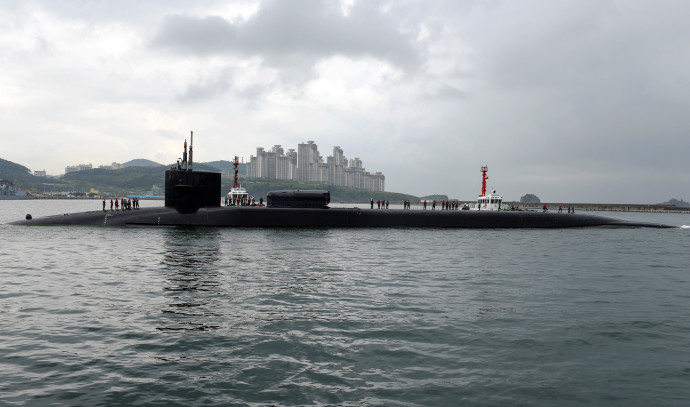When a US ballistic missile submarine (SSBN) surfaced for a rare visit to South Korea this week it was a blunt reminder that Washington always has nuclear-tipped missiles deployed within close striking distance of North Korea, analysts said.
Having nuclear weapons out of sight in the seas off the Korean Peninsula was a potentially stronger deterrent to the North, according to some analysts, than installing them in South Korea, as Washington had done from 1958 to 1991.
“Placing nuclear weapons offshore and on submarines is actually a stronger deterrent in many ways,” said Duyeon Kim of the Center for a New American Security. “Deterrence is strengthened when the location of American strategic assets is unknown to the adversary as long as the adversary knows that these weapons exist.”
The submarines journey to Korea
The USS Kentucky Ohio-class SSBN arrived in South Korea’s southern port of Busan on Tuesday and was still docked as of Friday, said Colonel Isaac Taylor, a spokesman for the US military in Korea.
The submarine got Pyongyang’s attention. On Thursday, its defense minister said the mere presence of such weapons in South Korea could meet the criteria for the North to use its nuclear weapons, and warned the US against sending any more nuclear-capable assets.
The Kentucky’s visit to South Korea was the first by an SSBN since the 1980s, and it follows an increasing debate in recent years over whether the United States should return tactical nuclear weapons to the South or whether Seoul should develop its own arsenal.
Giving reassurance of its commitment to defend the South, Washington has responded by stepping up displays of nuclear force and create a new group for war planning.
China, the North’s most important ally, has not commented on the submarine’s visit, but Beijing has accused the United States of increasing tensions in the region with its military deployments.
Because US SSBNs rely on secrecy and stealth to ensure their survival and preserve their ability to launch nuclear missiles during a war, they rarely make public stops in foreign ports.
SSBNs are the most survivable delivery platform of all the United States’ nuclear weapons, essentially guaranteeing overwhelming nuclear retaliation in the event of an enemy first strike, said Vann Van Diepen, a former US government weapons expert who now works with the 38 North project.
The US Navy fields 14 SSBNs, often referred to as “boomers”. An Ohio-class submarine carries 20 Trident II D5 missiles, each of which can deliver up to eight nuclear warheads to targets as far as 12,000 kilometers (7,500 miles) away.
“US SSBNs anywhere from the US West coast westward can strike targets in North Korea,” Van Diepen said. “Therefore, some US SSBNs are within range of North Korea at all times.”
North Korea has a large but aging submarine force whose primary mission is to defend its coastline, but is looking to develop its own arsenal of missile submarines.
It has conducted launches from a test submarine, and has been seeking to build an operational conventionally powered missile submarine since at least 2016, Van Diepen said.
But the North is many years away from developing the technical capability to build a nuclear-powered submarine that would give it unlimited range, he added. And, for now, a missile submarine would only marginally supplement the North’s burgeoning land-based nuclear force, Van Diepen said.



